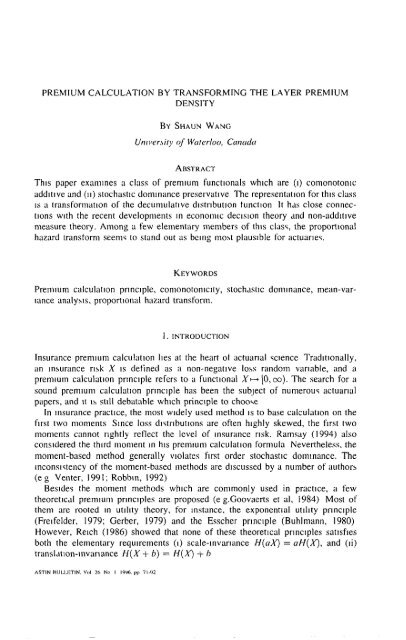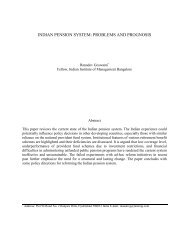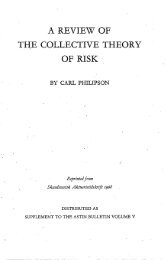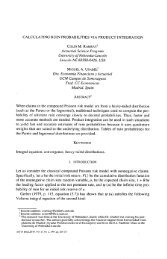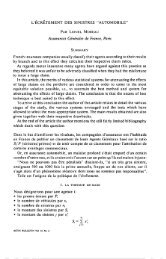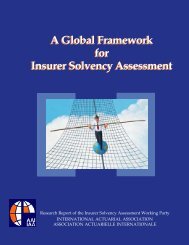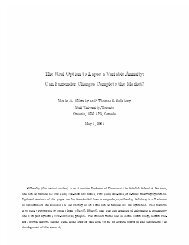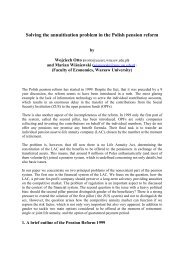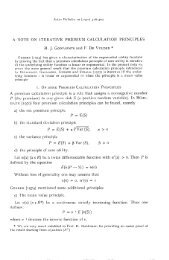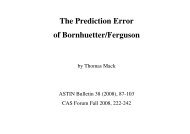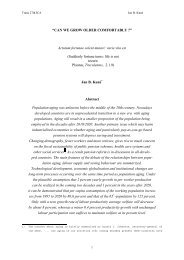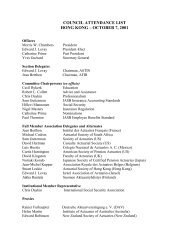premium calculation by transforming the layer premium density
premium calculation by transforming the layer premium density
premium calculation by transforming the layer premium density
Create successful ePaper yourself
Turn your PDF publications into a flip-book with our unique Google optimized e-Paper software.
PREMIUM CALCULATION BY TRANSFORMING THE LAYER PREMIUM<br />
DENSITY<br />
BY SHAUN WANG<br />
Umver3ity of Waterloo, Canada<br />
ABSTRACT<br />
This paper examines a class of premmm functtonals which are 0) comonotomc<br />
addmve and (u) stochastic don'unance preservative The representauon for this class<br />
is a Iransformatton of <strong>the</strong> decumulat.ve d,stnbutlon function It hds close connec-<br />
tions with <strong>the</strong> recent developments m economic decision <strong>the</strong>ory and non-addmve<br />
measure <strong>the</strong>ory. Among a few elementary members of this class, <strong>the</strong> propomonal<br />
hazard transtorm seem~ to stand out as being most plausible Ibr actuaries.<br />
KEYWORDS<br />
Premmm <strong>calculation</strong> principle, comonotomcxty, stochastic dominance, mean-var-<br />
iance analysis, proportional hazard transform.<br />
1. INTRODUCTION<br />
Insurance <strong>premium</strong> <strong>calculation</strong> lies at <strong>the</strong> heart- ot actuarial science Tradmonally,<br />
an insurance risk X is defined as a non-negative loss random variable, and a<br />
premmm <strong>calculation</strong> principle refers to a functional X~---~ [0, coo). The search for a<br />
sound premmm <strong>calculation</strong> principle has been <strong>the</strong> subJect of numerous actuarial<br />
papers, and It is still debatable which principle to choo,~e<br />
In insurance practme, <strong>the</strong> most w~dely used method is to base <strong>calculation</strong> on <strong>the</strong><br />
first two moments Since loss chstrtbuttons are often highly skewed, <strong>the</strong> first two<br />
moments cannot rightly reflect <strong>the</strong> level of insurance risk. Ramsay (1994) also<br />
considered <strong>the</strong> third moment m his <strong>premium</strong> <strong>calculation</strong> formula Never<strong>the</strong>less, <strong>the</strong><br />
moment-based method generally violates first order stochastic dolnmance. The<br />
mconst~,tency of <strong>the</strong> moment-based methods are d~scussed <strong>by</strong> a number of authors<br />
(eg Venter, 1991; Robbm, 1992)<br />
Besides <strong>the</strong> moment methods which are commonly used in practice, a few<br />
<strong>the</strong>oretical premmm pnnclples are proposed (e g.Goovaerts et al, 1984) Most of<br />
<strong>the</strong>m are rooted m utility <strong>the</strong>ory, for instance, <strong>the</strong> exponential utdtty principle<br />
(Freffelder, 1979; Gerber, 1979) and <strong>the</strong> Esscher pnnctple (Buhlmann, 1980)<br />
However, Reach (1986) showed that none of <strong>the</strong>se <strong>the</strong>oretical principles satisfies<br />
both <strong>the</strong> elementary requirements 0) scale-mvanance H(aX)= all(X), and 0i)<br />
translatlon-mvanance H(X + b) = H(X) + b<br />
ASTIN BULLETIN, Vol 26 No I 1996, pp 71-92
72 SHAUN WANG<br />
The Dutch principle (van Heerwaarden and Kaas, 1992) is defined as<br />
H(~=E[X+Om~{X-~E(X?,O}], 0 1<br />
It outperforms all prewous ones in <strong>the</strong> sense that it is scale-lnvarlant and translatlon-<br />
invarlant In addition, it preserves second order stochastic dominance. While <strong>the</strong> risk<br />
load component in <strong>the</strong> Dutch principle has a reinsurance explanation, <strong>the</strong> relative<br />
loading is too restrictive (below 100%). In practice, <strong>the</strong> price of a higher <strong>layer</strong> in<br />
casualty insurance may contain a risk load which can be many multiples of <strong>the</strong><br />
expected loss.<br />
Denneberg (1990) proposed an absohlte deviation principle:<br />
H(X)=E(a 3+0T(x?. 0
PREMIUM CALCULATION BY TRANSFORMING THE LAYER PREMIUM DENSITY 73<br />
2, LAYER NET PREMIUM DENSITY<br />
An insurance risk X is a non-negatwe random variable whose distribution is defined<br />
<strong>by</strong><br />
• <strong>the</strong> cumt, latlve dlstllbutlon function Fx(t) = Pr(X _< t}, or<br />
• <strong>the</strong> decumulatlve distribution function S~(t) = Pr{X > t}.<br />
In general, for a risk X, <strong>the</strong> expected loss can be evaluated directly from its<br />
decumulatlve d~strlbunon function:<br />
E(X) = &,(0at<br />
fO °<br />
Since most insurance contracts contain clauses such as deductible and nlaxnl~Unl<br />
hnm, ~t is convenient to use a general term of (excess-of-loss) <strong>layer</strong>s.<br />
Definition 1. A <strong>layer</strong> at (a, a + hi of a rtsk X ts defined as <strong>the</strong> loss from an eacess-of-<br />
loss cover<br />
O, O
74 SHAUN WANG<br />
3.1. Ordering of risks<br />
3 DESIRABLE PROPERTIES FOR A PREMIUM FUNCTIONAL<br />
Any <strong>premium</strong> prmctple mlphcltly mlphes an ordering of preference for all risks. It<br />
ts a natural reqmrement tor a <strong>premium</strong> principle to preserve some conm~on ordering<br />
of risks. As a simple rule of thumb, higher risks should be associated with higher<br />
<strong>premium</strong>s. In this section, we will introduce some basic concepts of stochastic<br />
dominance and apply <strong>the</strong>m to excess-of-loss <strong>layer</strong>s<br />
3.1.1. First stochastic dominance<br />
Definition 2. Xi precedes X2 under <strong>the</strong> .first stochastic dominance (FSD), if <strong>the</strong><br />
dectmndattve dtstrtbutlon functton of Xi ts everywhere lower.<br />
Xt- S.~(b + t), t > 0 ~ St~,,.~,, (t) > S~,~,, (t), t > 0<br />
If a <strong>premium</strong> principle H X ~ [0, c,v) preserves FSD, <strong>the</strong>n for a < b,<br />
l(bt,+h] ~l,t l(,a+h] ~ H(l(h,h+hl) _< H(l(a,o+h])<br />
As part of <strong>the</strong> FSD-preserwng requirement, we have.<br />
CI' The absolute premmm for <strong>layer</strong>s of a fixed width should decrease at upper<br />
<strong>layer</strong>s<br />
3.1.2. Second stochastic dommance<br />
Definition 3 Xi ts less dangerous than X 2 (X I -' Sx,(t) when t < to,<br />
Sx,(t) _< Sx2(t) when t _> to<br />
The second stochastic dominance (SSD) is a transmve closure of <strong>the</strong> ordering of<br />
dangerousness It has become a standard definiuon for a higher risk, partly due to<br />
Rothschdd and Stlghtz (1970)<br />
Definition 4 Xi precedes X2 under <strong>the</strong> second stochastic dominance (Xi '
2<br />
PREMIUM CALCULATION BY TRANSFORMING THE LAYER PREMIUM DENSITY 75<br />
Sx,(t)dt _ O<br />
For a task X, consider two <strong>layer</strong>s at (a, a + hi] and (b, b + h2] with <strong>the</strong> same net<br />
expected loss, i.e., E(l(,a,. + h,]) = E(l(b,b + h2])' Since <strong>the</strong> areas underneath <strong>the</strong> <strong>layer</strong><br />
net <strong>premium</strong> <strong>density</strong> for <strong>the</strong> two <strong>layer</strong>s are <strong>the</strong> same, when a < b it is necessary that<br />
hi < h2 In o<strong>the</strong>r words, <strong>the</strong> curve Sl~h+h ,(t) ls generally longer and thinner than<br />
Sl(aa+h l(t) As In Figure 1, St~,o+h i(t) an2d Sllbh+, l(t) cross once at <strong>the</strong> point hi<br />
which xnlphes that <strong>the</strong> <strong>layer</strong> at (b,b + h2] is a higher risk"<br />
](a,a + Ih] "
76 SHAUN WANG<br />
Definition 5 Xi and X2 are comonotontc tf <strong>the</strong>re exist a risk Z and weakly increasmg<br />
fimcttons f g such that Xi = f(Z) and X2 = g(Z).<br />
Since <strong>layer</strong>s and quota-shares are always increasing functions of <strong>the</strong> original risk,<br />
<strong>layer</strong>s or quota-shares of <strong>the</strong> same risk are comonotonlc. They are bets on <strong>the</strong> same<br />
event and nei<strong>the</strong>r of <strong>the</strong>m is hedge against <strong>the</strong> o<strong>the</strong>r.<br />
Now consider a colnbmed policy for two comonotontc risks Xi and X2. Because<br />
of <strong>the</strong> no-hedge condition, insurers are not willing to give a reduction in <strong>the</strong> risk-<br />
load for a combined policy, thus H(Xi + X2) > H(Xi) + H(X2). On <strong>the</strong> o<strong>the</strong>r hand,<br />
<strong>the</strong> maximum prenuum that insurers can demand for <strong>the</strong> combined policy is <strong>the</strong> .sum<br />
of two Individual risk <strong>premium</strong>s, since o<strong>the</strong>rwise <strong>the</strong> policy-holder can just buy<br />
separate policies, i e, H(Xi + Xz) < H(X~) + H(X2). To conclude, <strong>premium</strong>s should<br />
be addmve for comonotonlc risks' H(Xi+ Xz) = H(Xi)+ H(X2).<br />
As part of <strong>the</strong> reqmrement for comonotonlc addluvtty, we have.<br />
C3: Layer <strong>premium</strong>s should be additive. For any division 0 = Xo < x~<br />
< < .\',~ < ,<br />
H(.V) = ~ H(I(,,_ , ',1)<br />
I=1<br />
4 A CLASS OF PREMIUM PRINCIPLES<br />
4.1. Transforming <strong>the</strong> decumulative distribution function<br />
Based on <strong>the</strong> observation that Sx(t) is <strong>the</strong> <strong>layer</strong> net <strong>premium</strong> <strong>density</strong>, a natural idea<br />
would be to modify Sx(t) to get a 'risk-adjusted' <strong>layer</strong> <strong>premium</strong> <strong>density</strong> St(t):<br />
s(t) '<br />
Sy(t) :<br />
0 a a+h b b+h<br />
FIGURI: 2 An dlustrat~on of <strong>transforming</strong> <strong>the</strong> <strong>layer</strong> <strong>premium</strong> <strong>density</strong><br />
t
PREMIUM CALCULATION BY TRANSFORMING THE LAYER PREMIUM DENSITY 77<br />
Figure 2 illustrates <strong>the</strong> basic idea of transfomlmg <strong>the</strong> decumulattve dlstrlbuhon<br />
funcnon. The mterpretauons ,are as follows:<br />
1 It is necessary to have H(0) = 0 for a zero risk, whmh reqmres g(0) = 0<br />
2 The absolute premmm for <strong>layer</strong>s of <strong>the</strong> same width is decreasing ff and only<br />
ffSv(t) ~s weakly decreasing. This can be accomphshed if, and only If, g is an<br />
Increasing functmn<br />
3. Increased relative loading When u = Sx(t), <strong>the</strong> rehmve loading for an<br />
mfin|tes|mal <strong>layer</strong> at (t,t + dt] is<br />
g[S,~,(1)] _ g(u) _ g(u) - 0<br />
S.~,(t) , u - 0 '<br />
where <strong>the</strong> relative loading increases with t if, and only if, g is a concave<br />
functmn of u.<br />
4. Layer addmwty ~s automaucaliy sausfmd simply because <strong>the</strong> area under-<br />
neath <strong>the</strong> curve Sv(t) is additive<br />
5 Generally, foracertam lossPr{X= I} = 1 wehaveH(l)=g(l), lfwereqmre<br />
that H(I) = I <strong>the</strong>n g(1) = I, and Sv(t) = g[Sx(t)] defines ano<strong>the</strong>r decumulatlve<br />
&stnbutlon function<br />
Based on <strong>the</strong> above observations, we now define a class of <strong>premium</strong> principles<br />
Definition 6 For any increasing concaveJunctmn g, with g(0) = 0 and g(l) = 1, we<br />
define a corresponding ptenuum prmctple"<br />
H(X) = g[Sx(0]dt (1)<br />
The following properties are straight-forwardly verified'<br />
1<br />
2.<br />
E(X) O.<br />
Since<br />
{',<br />
s~,.,. +~(.)= s,.(~),<br />
we have<br />
O_
78<br />
.<br />
For a <strong>layer</strong> at (x,, x, ÷ i], we have<br />
SHAUN WANG<br />
H(I(,,,,, + ,]) = g[Sx(t)]dt<br />
Addmg up <strong>the</strong> <strong>layer</strong> premmms, we have<br />
t=O<br />
1<br />
H(I( ...... ,1) = g[Sx(t)]dt = H(X)<br />
/o<br />
H(X) preserves <strong>the</strong> FSD Xt ~1~, X2 ==,,. H(Xt) _< H(X2)<br />
4.2. Relative loading at higher <strong>layer</strong>s<br />
Consider <strong>the</strong> <strong>premium</strong> pnncJple m (1)<br />
H(X) = g[Sx(t)]dt,<br />
where g is an mcreasmg concave funcuon with g(0) = 0 and g(l) = 1<br />
Letting u ---- Sx(t), <strong>the</strong> relattve loading for an infinitesimal small <strong>layer</strong> at (t, t + dt]<br />
IS<br />
H( I(,,, + d,l) _ g[Sx(t)] _ g(u) - g(O)<br />
= + Sx(1) u - 0<br />
As t increases, u = Sx(t) decreases. Since g(u) zs concave, ~b(t) is an increasing<br />
functmn of t, ~ e. increased relauve loading at upper <strong>layer</strong>s<br />
Fur<strong>the</strong>rmore, ~t is easy to see that<br />
lira 4~(t)= hm g(u)- g(O)<br />
,,-0 u-0 -g'(0)<br />
It is noted that <strong>the</strong> relative loading at upper <strong>layer</strong>s does not exceed g'(0)<br />
In property/casualty (re)insurance, <strong>the</strong> risk load for extremely high <strong>layer</strong>s consists<br />
for <strong>the</strong> most part of <strong>the</strong> total <strong>premium</strong>. As observed in Venter (1991), a common<br />
phenomenon m reinsurance ratemaking is <strong>the</strong> mlmmum rate-on-hne, which ts <strong>the</strong><br />
<strong>premium</strong> dtv~ded <strong>by</strong> <strong>the</strong> coverage hrmt. Consider a <strong>layer</strong> at (t, t + h] Let <strong>the</strong> width<br />
(hmtt) h be fixed and <strong>the</strong> attachment point t move to <strong>the</strong> extreme right tail<br />
Generally <strong>the</strong> net <strong>premium</strong> E(I(,,, + hi) goes to zero as t goes to infimty. If g'(0)<br />
is fimte, <strong>the</strong> risk-adjusted premmm diminishes at <strong>the</strong> extreme right tat[.<br />
H(I(t.,+hl) _< g'(O)E(l(t,t+hl) ~ O, as t ~ cxD<br />
Therefore, based on <strong>the</strong> mmmmm rate-on-hne phenomenon, tt may be desirable to<br />
have g'(0) = oo.
PREMIUM CALCULATION BY TRANSFORMING THE LAYER PREMIUM DENSITY 79<br />
4.3. Preserving <strong>the</strong> SSD<br />
Theorem 1. The premuon prmclple m (1) preserves <strong>the</strong> second stochastm dom-<br />
171agice<br />
X'I ~2,,d X2 ~ H(XI) < H(X2)<br />
Proof: We only need to show that H(X) m (1) preserves <strong>the</strong> ordering of dangerous-<br />
ness Assume that E(Xi) _< E(X2) and <strong>the</strong>re exists to such that<br />
Sx,(t) > S~5(t ) when t < to,<br />
Sx,(t) < S,x~(t) when t >_ to.<br />
Now we construct a decumulauve dlstnbutmn function.<br />
Sz(t) = ,~'¢{s.v,(t),s.v:(,)} = f, &.,(l), t < t0;<br />
[ s.v~(t), t>/0<br />
Since <strong>the</strong> relative loading mcleases at upper <strong>layer</strong>s, we have<br />
and<br />
H(Z) - H(X,) ><br />
H(Z) - H(X2) <<br />
and <strong>the</strong> difference (2)-(3) yields<br />
4.4. Sub-additivity<br />
H(X2) - H(X,) ><br />
g[S,v, (to)] [S~ (t) - Sx, (t)]dt (2)<br />
S,v, (Io) ~fo °°<br />
g[Sx, (to)] fo '°<br />
Sx, (to) [&., (t) - s.~.~ (t)]d, (3)<br />
g[Sx,(t0)] [&.:(,) - s.y, (0]dt > 0<br />
&., (I0) . ~0 ~<br />
in Wang (1995), a proof(due to Ole Hessalager) was given for <strong>the</strong> sub-ad&tlvlty of<br />
<strong>the</strong> PH-transform prmmple That proof can be generalized to any transform g which<br />
is Increasing and concave<br />
Theorem 2. For any two non-negative randonl varlablea U and V regardless of<br />
dependence, <strong>the</strong> following inequality holds for <strong>the</strong> prenltunl principle (I).<br />
H( U + V) < H( U) + H(V)<br />
Proof: It is a straightforward generahzatlon of a proof m Wang (1995). []<br />
El
80 SHAUN WANG<br />
4.5. Extra loading for parameter uncertainty<br />
In pracnce, actuaries often encounter parameter uncertainty in thmr modehng. A<br />
common method to deal wtth parameter uncertamty ts to use a secondary mixing<br />
dtstnbutlon, that is, to describe <strong>the</strong> loss distribution as Sx(t I O) where 0 ~tself has<br />
ano<strong>the</strong>r dtstnbunon. It ~s a desirable property for a prermum functional to ymld extra<br />
risk load for parameter uncertainty. Now we demonstrate that <strong>the</strong> premmm func-<br />
tlonals in (1) possess this desirable property.<br />
Applying Jensen's mequahty to <strong>the</strong> concave funcnon g(z), we have<br />
Eog[Sx(t I 0)] < g[EoSx(t I 0)] = g[Sx(t)]<br />
Therefore, for <strong>the</strong> premmm prmmple m (I),<br />
= g[&(t)ldt 2 Fog[Sx(t I 0)]dt = &H(Xl 0),<br />
with strict mequahty unless 0 is degenerative<br />
As a specml case, if U 7~ V and X is a mixture'<br />
X = f U, with probabdlty a > 0,<br />
L V, with probabdxty I - a > 0;<br />
<strong>the</strong>n for <strong>the</strong> premmm prlnmple m (I), H(Jt~ > all(U) + (1 - a)H(V)<br />
4.6. Vertical slicing and comonotonic additivity<br />
Recall that <strong>the</strong> net expected loss E(X) is equal to <strong>the</strong> area below <strong>the</strong> curve Sx(t).<br />
While verncal shcmg gives E(X) = f~ Sx(t)dt, horizontal shctng yields that (see<br />
Figure 3)<br />
E(X~ = Si. I (q)dq. /o'<br />
where <strong>the</strong> reverse S~. I (q) may not be uniquely defined, however, It does not affect<br />
<strong>the</strong> mtegranon.<br />
One can easdy verify that for an mcreasmg funcnon g wxth g(0) = 0 and g(1) = 1,<br />
H(X) ---- g[Sx(t)]dt = S~ I (q)dg(q) (4)<br />
:0 :0<br />
Wtth <strong>the</strong> atd of hortzontal shcmg, we can now examme <strong>the</strong> concept of comonotomclty<br />
m terms of <strong>layer</strong> premmm dens~nes<br />
Lemma 1. If X and Y are comonotomc, <strong>the</strong>n <strong>the</strong> laver premzum densities are addlttve<br />
m <strong>the</strong> horizontal dtrecuon<br />
S;' (q) + S{ I (q) = S -I<br />
,~ . v(q), O < q
PREMIUM CALCULATION BY TRANSFORMING THE LAYER PREMIUM DENSITY 81<br />
~ ~<br />
Sl(q) t<br />
FIGURE 3 Shcmg a rink vemcally and horizontally<br />
Proof: See Denneberg (1994, p 57; 1990, p. 186).<br />
Theorem 3 The premmm principle m (1) ts addmve for comonotomc rtsks.<br />
Proof: From (4) and Lemma I we have<br />
H(X + Y~ = S~_ r(q)dg(q) = [S,-) (q) + S?' (q)dg(q) = H(X) + H(Y) J0 i0<br />
[]<br />
5 SOME ELEMENTARY TRANSFORMS<br />
In this section we xdentlfy some members within <strong>the</strong> class (I):<br />
H(X) = g[Sx(t)]dt, Jo<br />
where g is increasing concave with g(0) = 0 and g(l) = 1. We will especially look at<br />
some one-parameter famlhes of elementary transforms<br />
5.1. Proportional hazard transform<br />
The PH-transform principle (Wang, 1995) ns <strong>the</strong> slmpllest member of <strong>the</strong> class (l)<br />
with<br />
I<br />
g(x) =x~, p> 1<br />
It IS easy to see that g~(0) = c-~ = for p > 1.
82 SHAUN WANG<br />
In Wang (1995), <strong>the</strong> following notation is used for <strong>the</strong> risk-adJusted premmm:<br />
5.2. Dual-power functions<br />
The dual-power transform is a power transform of <strong>the</strong> cdf<br />
whmh Imphes that<br />
=<br />
F,.(,) = IF.,.(0 F ~ > l,<br />
Sy(t) = g[S~ (t)], g(x) = 1 - (l-x) c', cv> I,<br />
where g is increasing concave with g(0) = 0 and g(l) = I.<br />
Since g~(0) = c~, <strong>the</strong> relative loading at upper <strong>layer</strong>s is bounded <strong>by</strong> (e~ - 1)<br />
5.3. Denneberg's absolute deviation principle<br />
The absolute deviation prlnmple in Denneberg (1990) Is equivalent to <strong>the</strong> following<br />
pmcewlse linear transform (0 < r < 1)<br />
g(x) = ~'(I +r)x, 0_
PREMIUM CALCULATION BY TRANSFORMING THE LAYER PREMIUM DENSITY 83<br />
5.5. Square-root functions<br />
One can verify that<br />
5.6. Exponential functions<br />
One can verify that<br />
5.7. Logarithmic functions<br />
One can verify that<br />
5.8. Mixing and composing<br />
{---~- r>0,<br />
g(x) = ~er~-~ ,<br />
x, r = 0<br />
0 5r<br />
g'(0) = ~/1 + r- 1 < cxz<br />
l [ _e_Or<br />
g(x) = I-e-" ' c~ > O,<br />
X, ~=0<br />
--0;<br />
I.x, r=0<br />
r<br />
g'(0) - log(l + ,.) _ 0 with Z':= I P, = I, <strong>the</strong> function g = ~;'= I P,g, is also an mcreas-<br />
mg concave function with p(O) = 0 and g(I) = 1.<br />
(n) The function g(u) = g2[gl (u)] is also an increasing concave function with<br />
g(0) = 0 and g(l) = 1
84 SHAUN WANG<br />
By mixing and composing, one can get some two-pararneter farmhes of premmm<br />
principles. For instance, H(X) = OE(X) + (1 - 0)Tr,~(X), (0 < 0 < 1).<br />
5.9. Remarks<br />
(I) Among all <strong>the</strong> above elementary transforms, only <strong>the</strong> PH-transform has<br />
g~(0) : ~. This special feature will become mlportant in <strong>the</strong> performance<br />
test in <strong>the</strong> next section.<br />
(u) In <strong>the</strong> deflmtlon 6, one can allow g(1)-¢ 1, except for <strong>the</strong> property<br />
E(X) < H(X) < max(X), all o<strong>the</strong>r properties stdl hold. A smlple example<br />
is H(X) = cTrp(X), (c > 0)<br />
6.1. Mean-variance analysis<br />
6. A PERFORMANCE TEST<br />
The ma,n-stream defimtlon for a higher risk is based on FSD or SSD Since all <strong>the</strong><br />
premmm principles defined In (1) preserve FSD and SSD, we can now use some<br />
o<strong>the</strong>r criteria, namely <strong>the</strong> mean-variance (or higher moments) analysis, which has<br />
been widely used m finance and insurance risk <strong>the</strong>ory<br />
Example 1: Consider <strong>the</strong> following two risks<br />
f ¼, 0 _< t < 4,<br />
Su(t) (two point)<br />
l 0, 4
PREMIUM CALCULATION BY TRANSFORMING THE LAYER PREMIUM DENSITY 85<br />
6.2. Comparison of performance<br />
To compare <strong>the</strong> performance of various elementary transforms given m <strong>the</strong> preced-<br />
ing secUon, we apply <strong>the</strong> <strong>premium</strong> pnnclples to <strong>the</strong> two-point risk U and <strong>the</strong> Pareto<br />
risk W in Example I We choose <strong>the</strong> parameter values such that H(U) = 1.3 for all<br />
<strong>the</strong> <strong>premium</strong> principles.<br />
From Table I, one can see that only <strong>the</strong> PH-transform gives <strong>the</strong> Pareto risk W a<br />
<strong>premium</strong> higher than 1 3. (Recall that only <strong>the</strong> PH-transform has g'(0) = c~)<br />
For <strong>the</strong> PH-transform principle, we have<br />
7rp(U) = 4 f I { ~, p>_2<br />
For any p > 1, <strong>the</strong> risk-adjusted <strong>premium</strong> always assigns a higher premmm to <strong>the</strong><br />
Pareto risk (see Figure 4).<br />
E<br />
=<br />
E<br />
8<br />
J~<br />
Table 1. Prenuums for <strong>the</strong> two-point risk U and <strong>the</strong> Pareto risk W<br />
PRINCIPLE PARAMETER<br />
PH-transform p = 1 233<br />
Square-root r = 3.157<br />
Loganthn-uc r = I 055<br />
Exponennal ~ = 7594<br />
Quadratic r = 4<br />
Dual-power r = I 366<br />
Denneberg r = 3<br />
H (U) H (w)<br />
for <strong>the</strong> PareIo risk [ /<br />
1 25 1.5<br />
The PH-transform parameter -- rho<br />
3 608<br />
3 2903<br />
3 2782<br />
3 2708<br />
3 2667<br />
3 2662<br />
3 2485<br />
FIGURE 4 PH-transform always gives a htgher prenuum to <strong>the</strong> Paletn risk
86<br />
6.3 A remark<br />
SHAUN WANG<br />
We have seen that all <strong>the</strong> elementary transforms with g~(0) < cxz yield a lower<br />
<strong>premium</strong> to <strong>the</strong> Pareto risk, which confirms an earlier observation that, when g'(0) is<br />
finite, <strong>the</strong> relative loading does not increase fast enough at upper <strong>layer</strong>s<br />
A necessary condition for H(U) < H(W) seems to be that g'(0) = c
PREMIUM CALCULATION BY TRANSFORMING THE LAYER PREMIUM DENSITY 87<br />
Fur<strong>the</strong>nmore, H(X + Y) H(X)<br />
Venter (1991) has shown that every premmm principle which satisfies <strong>layer</strong>-<br />
addmvity comes flora tin adjusted dlsmbution principle. He also gave some ex-<br />
anaples: 0) <strong>transforming</strong> <strong>the</strong> probablhty <strong>density</strong> function f(z) to af(ax) (which is a<br />
scale transforln); and (u) mulnplymg <strong>the</strong> <strong>density</strong> f(x) <strong>by</strong> a non-neganve funcnon<br />
h(x) (a special case of which is <strong>the</strong> covanance principle) However, not every layel-<br />
addmve principle pleserves <strong>the</strong> FSD Albrecht (1992) gave an example to show that<br />
a scale transform can lead to a price below <strong>the</strong> expected cost for <strong>the</strong> retained portion<br />
below a franchise deductible.<br />
From Theorem 4 ~t becomes evident that m order to have both <strong>layer</strong>-addttll,tty<br />
and <strong>the</strong> preserving of FSD, one has to transform directly <strong>the</strong> decunmlatlve dlstrlbu-<br />
non funcnon. This would rule out <strong>the</strong> scale-transform and <strong>the</strong> covanance prmcmple.<br />
It IS noted that any transform Y= g(X) would lead to St(t) = Sx[g-I(t)], which<br />
modifies <strong>the</strong> function Sx( ) from ms,de, thus not a d~rect transform of <strong>the</strong> decu-<br />
mulat~ve dlsmbutmn funcuon.<br />
1
88 SHAUN WANG<br />
8 ECONOMICS OF INSURANCE<br />
8.1 Expected utility <strong>the</strong>ory: an old time religion<br />
Utility <strong>the</strong>ory was introduced to insurance economics <strong>by</strong> Borch (1961) and since<br />
<strong>the</strong>n it has been playing a dominant role Given xmtlal wealth COo and an agent's<br />
uUhty funcUon u, <strong>the</strong> <strong>premium</strong> that <strong>the</strong> agent is willing to pay (or accept) for<br />
insuring risk X can be derived from <strong>the</strong> expected utility equation:<br />
u(w0 - P) = E[u(~0 - X)]<br />
Within this conceptual framework, a number of premluln principles have been<br />
developed <strong>by</strong> European actuaries (see Goovaerts et al, 1984); for instance, <strong>the</strong><br />
exponential utdlty principle The widely-used variance principle P(X) + c~ Var(X)<br />
can be viewed as an approximation from <strong>the</strong> expected utility equation <strong>by</strong> using <strong>the</strong><br />
first two terms of Taylor expansion<br />
Embedded m <strong>the</strong> expected utthty <strong>the</strong>ory are some precise orderlngs of preference.<br />
The first stochastic dominance is <strong>the</strong> common ordering shared <strong>by</strong> all decision-<br />
makers with Increasing utility functions. The second stochastic dominance is <strong>the</strong><br />
common ordering shared <strong>by</strong> all decxslon-makers with increasing concave utility<br />
functions It is this precise ordering of preference that makes expected utility <strong>the</strong>ory<br />
a very popular conceptual framework<br />
Let <strong>the</strong> symbol >- and ,~ represent strict preference and indifference, respectively.<br />
As for Euchdean geometry, <strong>the</strong> utility <strong>the</strong>ory is based on five axioms (e.g Fishburn,<br />
1982)<br />
EU.1<br />
EU.2<br />
EU 3<br />
EU 4<br />
EU 5<br />
If prospects V~ and V2 have <strong>the</strong> same cumulative distribution function, <strong>the</strong>n V~<br />
V 2<br />
Weak order L- xs reflecuve, transmve and connected.<br />
L- is continuous m <strong>the</strong> topology of weak convergence.<br />
preserves <strong>the</strong> FSD<br />
If Sv. L- Si,,, for and any p E [0, 1], <strong>the</strong> probablhstlc mixture satisfies:<br />
[(l - p)Si:, + pS,,2] ~_ [(l - p)sl> + pSv,],<br />
From <strong>the</strong> above five axioms of preference, one can show <strong>the</strong> existence of a utility<br />
function u such that 'V, >- V2 ,f and only If E[u(V,)] ~ E[u( Z2)].'<br />
The axiomatic foundation makes many people believe that utlhty <strong>the</strong>ory is <strong>the</strong><br />
only legitimate <strong>the</strong>oretical tool for analyzing decxslon under uncertainty, which<br />
itself explains its dominant role in <strong>the</strong> economics of msulance.<br />
While economists are mainly concerned with <strong>the</strong> ordering of preference, actuaries<br />
are interested in concrete numbers m real terms (dollars, pounds, etc) Unfortu-<br />
nately, <strong>the</strong> expected utility paradigm does not promise a consistent <strong>premium</strong><br />
principle (e.g. Reich, 1986) In fact, <strong>the</strong> <strong>layer</strong>-addltlV~ty only holds for linear utility<br />
functions.
PREMIUM CALCULATION BY TRANSFORMING THE LAYER PREMIUM DENSITY 89<br />
8.2. Yaari's dual <strong>the</strong>ory of choice under risk<br />
As with <strong>the</strong> Euchdean axiom system, a number of people challenged <strong>the</strong> fifth axmm<br />
m <strong>the</strong> expected unhty <strong>the</strong>ory (e g. Allals, 1953, Machma, 1982) Qmggln (1982)<br />
proposed an anticipated unllty <strong>the</strong>ory which does not follow <strong>the</strong> expected utdlty<br />
axioms<br />
In an independent approach, Yaan (1987) proposed an alternanve to <strong>the</strong> fifth EU<br />
axIoIn.<br />
EU 5* If Vl, V2 and V3 are comonotomc and Vl _>- V2, for any p E [0,1], <strong>the</strong><br />
outcome mixture sausfies: ( 1 - p) Vi + p//3 >'- ( I - p) I/2 + p V3.<br />
By replacing <strong>the</strong> fifth axtom EU.5 <strong>by</strong> EU.5*, Yaarl (1987) developed a dual<br />
<strong>the</strong>ory of choice under r, sk, whmh turns out to be a specml case of Qmggm (1982)<br />
Yaarl's ax,omatm approach breaks <strong>the</strong> old behef that <strong>the</strong> expected utlhty paradigm<br />
is <strong>the</strong> only legitimate <strong>the</strong>orencal tool for analyzing decision under uncertainty.<br />
Under axmm EU 1-4 & EU.5*, Yaarl (1987) showed that <strong>the</strong>re exists a dual<br />
utlhty funcnon h-[0, 1] + [0, I] such that a certain equtvalent to a random<br />
economic prospect V on interval [0,1] IS<br />
where <strong>the</strong> funcnon h Is convex when an agent ,s risk-averse<br />
Now assume that an agent has inmal wealth I and is facing a random loss X on<br />
<strong>the</strong> interval [0,1] By facing risk X, <strong>the</strong> agent's economic prospect is V = 1 - X. Let<br />
P be <strong>the</strong> ,nsurance <strong>premium</strong> for risk X Analogous to <strong>the</strong> expected utlhty equatmn,<br />
we have a certain-equivalent relatton:<br />
l - P = ~0 I h[S,_ x(t)]dt<br />
S,nce Si - x(t) = Pr{X < 1 - t}, we have<br />
1 - P = h[l - Sx(I - t)]dt = h[l - Sx(z)]dz,<br />
/0' /0'<br />
e = g[Sx(z/l(< where g(x) = I - h(l - x)<br />
/o'<br />
One can verify that g is concave if and only if h is convex.<br />
As a special case of Yaarl's equation (5), if h(x)= 1-(1- x)', we get<br />
g(x) = xZ which corresponds to <strong>the</strong> PH-transform m Wang (1995) It is noted that<br />
Yaarl's axmmatlzatlon is vahd for uniformly bounded random variables, whereas<br />
<strong>the</strong> PH-transform <strong>premium</strong> functional is defined also for unbounded random van-<br />
ables. (A referee pointed out that <strong>the</strong> contlnmty axiom may have to be weakened or<br />
modified in order to mclude unbounded random variables)<br />
(5)
90 SHAUN WANG<br />
8.3 Economic interpretations<br />
Firstly we need to &stlnguxsh between two types of risk-aversion<br />
• R~sk-averslon-I' <strong>the</strong> tladltlonal utility <strong>the</strong>ory expresses as an attitude towards<br />
wealth, m <strong>the</strong> mean whde it is hnear with respect to probabdlty.<br />
• Risk-avelslon-2. The proposed <strong>premium</strong> principle (1) describes as an attitude<br />
towards probabdltles (uncertainty), in <strong>the</strong> mean while it ~s hncar with respect to<br />
wealth<br />
When interpreting <strong>the</strong> premluln principle (1), we wish to &stmgmsh in&vldual<br />
insurers and <strong>the</strong> whole Insurance industry<br />
• An insurer <strong>by</strong> itself can only take on hmlted liability If <strong>the</strong> loss is small scale<br />
relative to its financial capacity, <strong>the</strong> insnrer exhibits local risk-aversion-2<br />
However, at relatively large loss scales, an insurer may start to exhibit risk-<br />
aversion- 1. Even though thc threshold for this transition may not be clear-cut, it<br />
may be modeled <strong>by</strong> a utility function or <strong>by</strong> using a inaxmlum variance<br />
consttalnt.<br />
• The whole insurance industry, as a collective of mdlv~dual COlnpanles compet-<br />
Ing In <strong>the</strong> insulance market, cannot feel "pain' as a ~esuh of any single loss, so it<br />
cannot be risk-averse-1 On <strong>the</strong> o<strong>the</strong>r hand, <strong>the</strong> insurance industry is in a<br />
business to make a profit. We can say that 'profit-seeking' is a hidden nalne fol<br />
being 'risk-averse-2'.<br />
• Indlwdual insurers are price-takers, not price-makers (Meyers, 1991)<br />
premmm principle (1) inay prowde a model for market pretnlums<br />
Regarding addmvlty, we have <strong>the</strong> following comments.<br />
• Traditional variance principle and exponential utlhty principle are additive for<br />
independent risks but super-additive for comonotonlc risks<br />
• By contrast, <strong>the</strong> premlutn principle (1) Is additive for COlnOnotonlc risks but<br />
strictly sub-additive for independent risks<br />
• The strict sub-addltwlty for independent (or less correlated) risks explains <strong>the</strong><br />
mechamsm for r,sk exchange However, one has to adlmt that <strong>the</strong> insulance<br />
market is not as efficient as <strong>the</strong> financial market Significant transaction costs<br />
may discourage many <strong>the</strong>oretically justifiable risk-exchanges<br />
• As an operational rule, insurers may apply <strong>the</strong> prenamm plmclple (I) to<br />
individual risks ra<strong>the</strong>r than to <strong>the</strong> collective claim &strlbutxon. In which case,<br />
addltlVlty holds for indlwdual risks.<br />
• Theoretically, suppose that transaction costs are negligible, <strong>the</strong> optmaal strategy<br />
is to form cross-hedging for all dlverslflable risks (e.g. form a loss index of all<br />
companies combined) The remaining risks (and <strong>the</strong>ir <strong>layer</strong>s or quota-shares) are<br />
all comonotonlc The <strong>premium</strong> principle (I) is ad&tlve for comonotomc risks<br />
The
PREMIUM CALCULATION BY TRANSFORMING THE LAYER PREMIUM DENSITY 91<br />
8.4. Conclusion<br />
In this paper we have discussed a class of <strong>premium</strong> principles defmed <strong>by</strong><br />
H(X) = g[Sx(t)]dt,<br />
where g Is increasing concave with g(0) = 0 and g(l) = I The <strong>premium</strong> principle<br />
H(X) is comonotonic-addinve and preserves <strong>the</strong> second stochastic dominance, its<br />
close connections with <strong>the</strong> recent developments in economic decision <strong>the</strong>ory may<br />
make it more jusnfiable. In order to get unbounded relative loading at upper <strong>layer</strong>s,<br />
as supported <strong>by</strong> <strong>the</strong> minimum rate-on-hne phenomenon in reinsurance ratemakmg,<br />
an addmonal requirement ~s that g'(0)= c~ After investigating a number of<br />
elementary transforms, <strong>the</strong> PH-transform seems to stand out as <strong>the</strong> most plausible<br />
method for actuaries.<br />
ACKNOWLEDGMENTS<br />
Part of this paper was presented at <strong>the</strong> Casualty Actuaries Reinsurance Semmar In<br />
New York, June 26-27, 1995. The completion of this wolk was supported <strong>by</strong> an<br />
AERF/CKER joint grant The author thanks Harry Panjer, Gary Venter and an<br />
anonymous referee for comments and suggestions.<br />
REFERENCES<br />
ALBRECHI, P (1992) Premmm <strong>calculation</strong> without arbnr,lge '~ A note on a contribution <strong>by</strong> G Venter<br />
ASTIN Bulletul, 22, 247-254<br />
ALLAIS, M (1953) Le comportelnent de I'homme rat~onel devant le nsqtle critique des axioms et<br />
postulates de I'ecole Amencame Econometrtca 21(4), 503-46<br />
BORCH, K H (1961) The utlhty concept apphed to <strong>the</strong> <strong>the</strong>ory of insurance ASTIN Bulletin, 1. 170-191<br />
BUHLMANN, H (1980) An econonuc prenuum prmople ASTIN Bulletin, 11, 52-60<br />
DENNEnlZRG, D (1990) Premium <strong>calculation</strong> why standard dewatlon should be replaced <strong>by</strong> absolute<br />
deviation ASTIN Bulletin, 20 181-190<br />
DENNEBERG, D (1994) Non-Addttttue Measure And Integral Kluwer Academic Pubhshers, Boston<br />
FISHaUR~, P (1982) The Foundations ofEapected Uuhty Reldel, Dordrecht, Holland<br />
FREIFELDER, L R (1979) Exponentml Utdlty <strong>the</strong>ory ratemakmg an alternative ratemakmg approach<br />
Journal of Rt~k and Insurance, 46 515-530<br />
GERaER, H U (1979) An hltto~h~cttou to Ma<strong>the</strong>mancal Risk Theory Huebner Foundation Monograph,<br />
Wharton School. Umverslty of Pennsylvanm<br />
GOOVAERTS, M J , DE VYLI)ER, F AND HAEZENDONCK, J (1984) Insurance Premiums Theola and<br />
Apphcauona Norlh-Holhlnd, Amsteldam<br />
KAAS. R , VAN HEERWA^RDCN, A E, AND GOOVA~RTS, M J (1994) Ordering of Actualtal Rtaks<br />
Ceutenck, Leuven. Belgium<br />
MACHINA, M (1982) 'Expected Utthty' analysis without <strong>the</strong> independence ,l~lOm Econometltca, 50(2),<br />
217-323<br />
MEVI:KS, G G (1991) The competitive market equdlbltum risk load formula fol increased hnuts<br />
ratemakmg Proceedings of <strong>the</strong> Casualty Actuarial Society Vol LXXVIll, 163-200<br />
QUIGGIN, J (1982) A <strong>the</strong>ory of antlopated Utdlty Journal of Economic Betlal,tor and Oigamzauon, 3(4),<br />
323-43
92 SHAUN WANG<br />
RAMSAY. C M (1994) Loading gross premtums for risk wtthout using utdlty <strong>the</strong>ory, with Discussions<br />
Transactton~ o/<strong>the</strong> Soctetv of Actuartea Vol XLV, p 305-349<br />
REICH, A (1986) Propemes of premmm <strong>calculation</strong> principles Insurance Ma<strong>the</strong>matwa and Economtcs, 5,<br />
97-101<br />
ROI~BIN, (1992) Discussion of Meyers' paper- The competltwe market eqmhbrtum risk load formula lbr<br />
increased hnuts ratemakmg Pioceedmg~ of <strong>the</strong> Caaualty Actuattal Soctet 3 Vo[ LXXIX, 367-384<br />
ROTSCHIELD, M AND SIIGLITZ, J E (1970) lncleasmg risk I a definttlon Joun~alfo Ecommuc Theory 2.<br />
225-243<br />
SCI-IMEIDLER, D (1986) Integral representauon without acldmvHy Proceedtngs of <strong>the</strong> Atnetlcan<br />
Ma<strong>the</strong>matwal Socwty, 97 225-261<br />
VAN HELRWAARDEN, A E AND KAAS, R (1992) The Dutch premmm prmclple Insurance Ma<strong>the</strong>matt69<br />
and Economws, I1, 129-133<br />
VFNTER. G G ( 1991 ) Premmm calculauon mmphcat~ons of reinsurance wtthout arbitrage ASTIN Bulletin,<br />
21, 223-230<br />
WANG, S (1995) Insurance Pricing And Increased Lmuts Ratemakmg By Proporltonal Hazards<br />
Transforms b~sur~nce Malhdtn~Ttt63 and liconoml~ ~, 17, 43-54<br />
YAARI, M E (1987) The dual <strong>the</strong>ory ot chotce under risk Econometrtca, 55 95-115<br />
ADDRESS OF THE AUTHOR<br />
Dept. of Stattsttcs and Actuartal Sctence<br />
Untverstty of Waterloo<br />
Waterloo, ON N2L 3GI Canada<br />
E-mad" sswang@math.uwaterloo.ca


